 Portrait of Charles II
Portrait of Charles II
Sir George Oxenden (1620–1669) was the first governor of the Bombay Presidency during the early rule of the British East India Companyin India.
He was the third son of Sir James Oxenden of Dene, Kent, knight, and of Margaret, daughter of Thomas Nevinson of Eastry, Kent, and was baptised at Wingham on 6 April 1620. He spent his youth in India, and on 24 November 1661 was knighted at Whitehall Palace. At the time the London East India Company had a new charter from Charles II, but the king's marriage to Catherine of Braganza involved the company because the island of Bombay had, under the marriage treaty, been ceded by Portugal to England, and it lay within the company's territories. The court of directors in March 1661 resolved to restore their trade in the East Indies, and appointed, on 19 March 1662, Sir George Oxenden to the post of president and chief director of all their affairs at Surat,

and all other their factories in the north parts of India, from Ceylon to theRed Sea. A
and all other their factories in the north parts of India, from Ceylon to theRed Sea. A
Oxenden found on his arrival in India that the company's trade was limited to the presidencies of Surat and Fort St. George, and to the factory at Bantam. The king's troops were coming from England to keep down private trade. Sir George Oxenden was instructed to assist them, and to abstain from embroiling the company with foreign powers. The States-General of Holland were contesting the supremacy of the sea in Asia; English troops arrived, but were unable to obtain the immediate cession of Bombay, and Sir George Oxenden was prevented from assisting them by increased complications. France joined Holland in threatening the company's trade, while the Mogul chieftains showed themselves jealous of English predominance. Aurungzebe, the Mogul emperor,

looked for advantage from the superior naval powers.
looked for advantage from the superior naval powers.
Sir Abraham Shipman, the commander of the royal troops, found himself powerless to take or hold Bombay, and therefore proposed to cede it to the company. Meanwhile the government offered the whole of the trade of that port to the company, in return for the company's aid against the Dutch. Both these offers were under Oxenden's consideration when, in January 1664, Surat was suddenly attacked by a force of Marathas,

Plate 9, "Logie van Suratte," a view of the Dutch East India Company's warehouse and living quarters in Surat as seen in April 1629 by Pieter van den Broecke (1585-1640), a Dutch cloth merchant in the service of the Dutch East India Company (VOC); CLICK ON THE IMAGE FOR A VERY LARGE SCAN.
This copperplate engraving from 'Historische ende Iournaelsche Aentekeningh, van 't gene Pieter van den Broecke op sijne Reysen, soo van Cabo Verde, Angola, Gunea en Oost-Indien voorghevallen is.... (Pieter van den Broecke: Voyages to West Africa and Asia 1605-1630.), which was part of the monumental work by Isaac Commelin (1598-1676) on VOC voyages: 'Begin ende voortgangh van de Vereenighde Nederlantsche Geoctroyeerde Oost-Indische Companie....', was published by Joannes Janssonius, Amsterdam, 1646.
A panoramic view of Surat, in which the Dutch logie is marked with "3"; an engraving by Jacob Koppmayer from Wagner's 'Delineatio provinciarum Pannoniae et Imperii Turcici', Augsburg, 1687; CLICK ON EITHER HALF OF THE ENGRAVING FOR A VERY LARGE SCAN
And then its later destiny:
"The Lodge of the English at Suratte-- 1) The Church; 2) The House; 3) The Armory; 4) The Coach-house," from 'Lo Statto presente di tutti i paesi e popoli del mondo...', a translation of the work of *Thomas Salmon*, published in Venice, 1751; CLICK ON THE IMAGE FOR A VERY LARGE SCAN
Bellin's view of Surat, from Prevost's 'Histoire Generale des Voyages', c.1750; CLICK ON THE IMAGE FOR A VERY LARGE SCAN

How to get to Surat: a navigator's map (showing channels and water depths) by Pieter van der Aa, from 'La Galerie Agreable du Monde (...).Tome premier des Indes Orientales.', published in Leyden, c. 1725
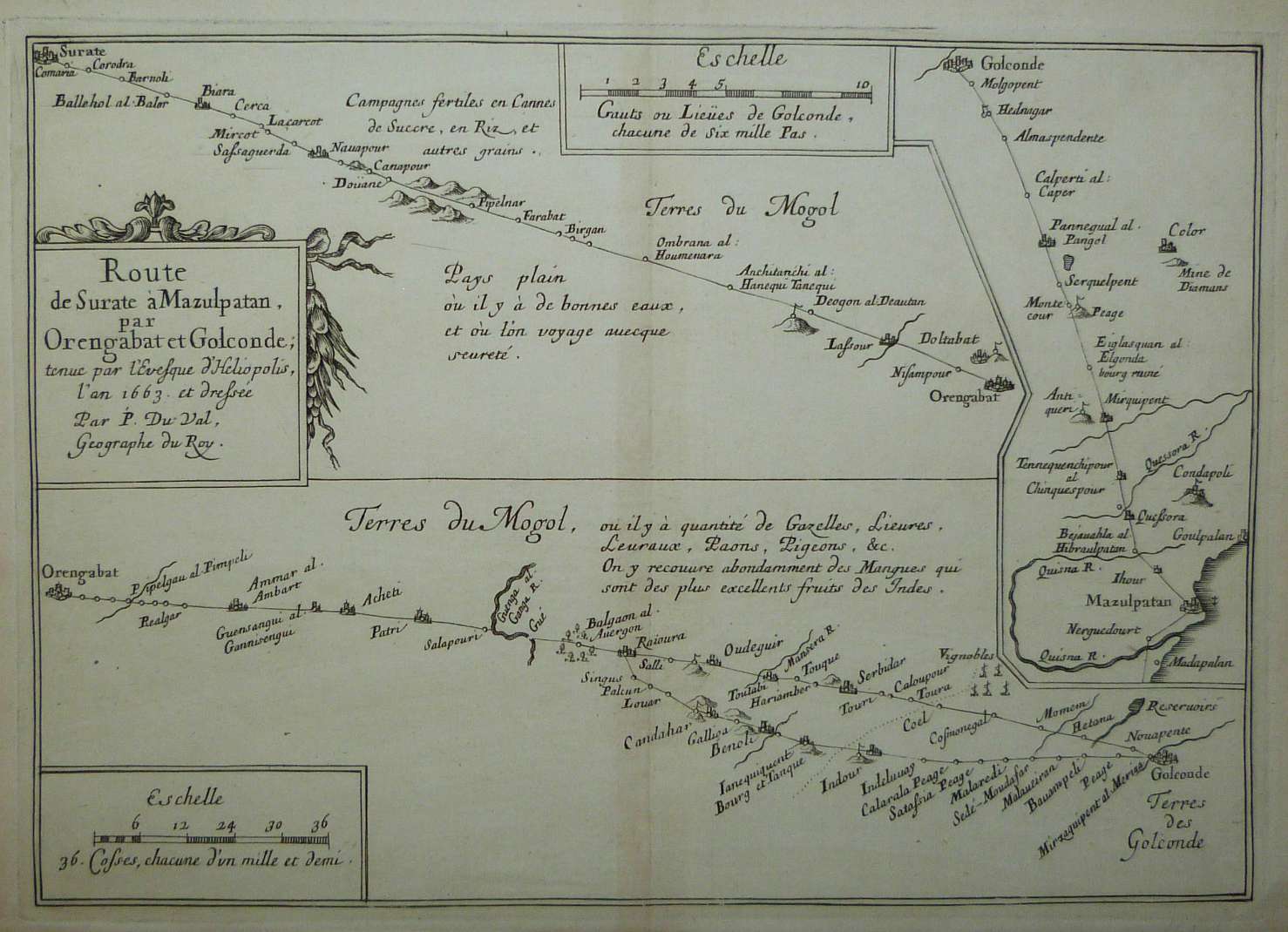
Where to go from Surat: a map of trade and travel routes through the Deccan, by Pierre du Val, 1690 (with special praise for the local mangoes)
"The Lodge of the English at Suratte-- 1) The Church; 2) The House; 3) The Armory; 4) The Coach-house," from 'Lo Statto presente di tutti i paesi e popoli del mondo...', a translation of the work of *Thomas Salmon*, published in Venice, 1751; CLICK ON THE IMAGE FOR A VERY LARGE
consisting of some four thousand horse under the command of Shivaji.

INDOSTAN - SURAT
The Dutch East India Company's "logie" at Surat, 1629 [1646]
Plate 9, "Logie van Suratte," a view of the Dutch East India Company's warehouse and living quarters in Surat as seen in April 1629 by Pieter van den Broecke (1585-1640), a Dutch cloth merchant in the service of the Dutch East India Company (VOC); CLICK ON THE IMAGE FOR A VERY LARGE SCAN.
This copperplate engraving from 'Historische ende Iournaelsche Aentekeningh, van 't gene Pieter van den Broecke op sijne Reysen, soo van Cabo Verde, Angola, Gunea en Oost-Indien voorghevallen is.... (Pieter van den Broecke: Voyages to West Africa and Asia 1605-1630.), which was part of the monumental work by Isaac Commelin (1598-1676) on VOC voyages: 'Begin ende voortgangh van de Vereenighde Nederlantsche Geoctroyeerde Oost-Indische Companie....', was published by Joannes Janssonius, Amsterdam, 1646.
A panoramic view of Surat, in which the Dutch logie is marked with "3"; an engraving by Jacob Koppmayer from Wagner's 'Delineatio provinciarum Pannoniae et Imperii Turcici', Augsburg, 1687; CLICK ON EITHER HALF OF THE ENGRAVING FOR A VERY LARGE SCAN
And then its later destiny:
"The Lodge of the English at Suratte-- 1) The Church; 2) The House; 3) The Armory; 4) The Coach-house," from 'Lo Statto presente di tutti i paesi e popoli del mondo...', a translation of the work of *Thomas Salmon*, published in Venice, 1751; CLICK ON THE IMAGE FOR A VERY LARGE SCAN
Bellin's view of Surat, from Prevost's 'Histoire Generale des Voyages', c.1750; CLICK ON THE IMAGE FOR A VERY LARGE SCAN

How to get to Surat: a navigator's map (showing channels and water depths) by Pieter van der Aa, from 'La Galerie Agreable du Monde (...).Tome premier des Indes Orientales.', published in Leyden, c. 1725

Where to go from Surat: a map of trade and travel routes through the Deccan, by Pierre du Val, 1690 (with special praise for the local mangoes)
"The Lodge of the English at Suratte-- 1) The Church; 2) The House; 3) The Armory; 4) The Coach-house," from 'Lo Statto presente di tutti i paesi e popoli del mondo...', a translation of the work of *Thomas Salmon*, published in Venice, 1751; CLICK ON THE IMAGE FOR A VERY LARGE
consisting of some four thousand horse under the command of Shivaji.
The inhabitants fled, the governor shut himself up in the castle, while Oxenden and the company's servants fortified the English factory. Oxenden and his party defended themselves successly but Shivaji took away an immense booty. Oxenden received the thanks of Aurungzebe, and an extension of the privileges of trade to the English, with an exemption of the payment of customs for one year.
In March 1667, Charles II ceded Bombay

to the East India Company, and they commissioned Oxenden to take possession of the island of Bombay. In August of that year the court of directors appointed him governor and commander-in-chief of Bombay, with power to nominate a deputy-governor to reside on the island, but he was placed under the control of the president and council of Surat. On 21 September 1667 the island was formally ceded by the royal troops to the new governor. The English officers and privates there were invited to enter the company's service, and thus the first military establishment of the East India Company at Bombay was created. On 14 July 1669 Oxenden died at Surat, and the company erected a monument over Sir George's grave there.
to the East India Company, and they commissioned Oxenden to take possession of the island of Bombay. In August of that year the court of directors appointed him governor and commander-in-chief of Bombay, with power to nominate a deputy-governor to reside on the island, but he was placed under the control of the president and council of Surat. On 21 September 1667 the island was formally ceded by the royal troops to the new governor. The English officers and privates there were invited to enter the company's service, and thus the first military establishment of the East India Company at Bombay was created. On 14 July 1669 Oxenden died at Surat, and the company erected a monument over Sir George's grave there.
His nephew, Sir Henry Oxenden, 3rd Baronet (d. 1709), who was for a short time deputy-governor of Bombay, was second son of George Oxenden's elder brother Henry, who was knighted on 9 June 1660, was M.P. for Sandwich, and was created a baronet on 8 May 1678. The latter's third son was George Oxenden the civil lawyer.

--------------------------------------------------------------------0-----------------------------------------------------------------------------------------------------------------------------------------------------------------------------------------------------------------------------------------------------------------------------------------------------------------------------------------------------------------------------------------------------------------------Gerald Aungier (died 1677--------------------------------------------------------------------------------------------------------------------------------------Gerald Aungier (died 1677) was the second Governor of Bombay. He was made the president of the Surat factor and the governor of Bombay in 1672
, which posts he held till 1675. He was responsible for the initial growth of the city.
![[Surat-4.jpg]](https://blogger.googleusercontent.com/img/b/R29vZ2xl/AVvXsEj6tRbXAjmN69FYCtbZrpwKTShQCy3j9aC49k2GRsfLh4nwDFy2lMC7H6mLS1pW965Gh5-3rG_-LKnVqRKU1_wEqjmwQKyv5bMFgz962SLPKBbAI7pLx_Znha3vdnEtbxxgSUA-Jv2Yjg0j/s1600-rw/Surat-4.jpg)
ENGLISH CEMETERY IN SURAT
THE EARLY EUROPEAN TOMBS AT CITY OF SURAT (GUJARAT,INDIA) DATING FROM SEVENTEENTH CENTURY ARE AMONG THE MOST IMPORTANT MONUMENTS AT SURAT.THE EARLIEST AND ONE OF THE MOST ATTRACTIVE TOMBS IN THE CEMENTERY IS THAT OF FRANCIS BRETON PRESIDENT OF THE ENGLISH FACTORY WHO DIED IN A.D.1649, ANOTHER IS AN IMPOSING MAUSOLEUM IN THE CEMETERY OVER THE GRAVES OF CHRISTOPHER AND SIR GEORGEOXENDEN.
 TOMB OF CHRISTOPHER OXENDEN:
TOMB OF CHRISTOPHER OXENDEN:
 TOMB OF CHRISTOPHER OXENDEN:
TOMB OF CHRISTOPHER OXENDEN:CHRISTOPHER DIED IN 1659 AND A DOMED STRUCTURE WITH FOUR PINNACLES AT THE CORNERS WAS ERECTED OVER HIS GRAVE AN EPITAPH IN LATIN AND OLD ENGLISH CHARUCTERS WAS PLACED WITH IN IT BY HIS BROTHER AND PRESIDENT OF THE ENGLISH FACTORY GEORGE OXENDEN,  WHO DIED LATER IN 1669A.D.
WHO DIED LATER IN 1669A.D.
 WHO DIED LATER IN 1669A.D.
WHO DIED LATER IN 1669A.D.SIR GEORGE WAS ALSO BURIED IN THE SAME MAUSOLEUM AND A CAFTIER AND MOST EXPENSIVE CUPOLA WAS RAISED OVER THE SAME MAUSOLEUM IN THE UPPER COMPART MENT OF THIS BUILDING IS INSERTED A LARGE MARBLE SLAB BEARING AN INSCRIPTION IN LATIN TO
THE MEMORY OF SIR GEORGE.
Bombay Fort from the Harbour 1665 to 1700 Bombay now Mumbai Maharashtra India Asia old vintage engraving 1600s 1700s Stock Photo - Alamy
The Port Of Bombay in 1732, India 18th century. London, British Library, Stock Photo, Picture And Rights Managed Image. Pic. DAE-11316859 | agefotostock
| Name | Portrait | Assumed office | Left office | Years in office | Remarks[a] | |
|---|---|---|---|---|---|---|
| 1 | George Oxeden 1ST | 23 September 1668 | 14 July 1669 | 1 | ||
| 2 | Matthew Gray (ACTING) | 14 July 1669 | 7 June 1672 | 3 | Acting | |
| 3 | Gerald Aungier 2ND | 7 June 1672 | 30 June 1677 | 5 | ||
| 4 | Henry Oxenden | 30 June 1677 | 27 October 1681 | 4 | ||
| 5 | John Child | 27 October 1681 | 27 December 1683 | 2 | ||
| 6 | Richard Keigwin[b] | 27 December 1683 | 19 November 1684 | 1 | Acting | |
| 7 | Charles Zinzan | 19 November 1684 | 1685 | 1 | Acting | |
| 8 | John Wyborne | 1685 | 2 May 1687 | 2 | Acting | |
| 9 | John Child | 2 May 1687 | 4 Feb 1690 | 3 | ||
| 10 | Bartholomew Harris | 4 February 1690 | 10 May 1694 | 4 | ||
| 11 | Daniel Annesley | 10 May 1694 | 17 May 1694 | Acting | ||
| 12 | John Gayer | 17 May 1694 | November 1704 | 10 | ||
| 13 | Nicholas Waite | November 1704 | September 1708 | 4 | ||
| 14 | William Aislabie | September 1708 | 11 October 1715 | 7 | ||
| 15 | Stephen Strutt | 11 October 1715 | 26 December 1715 | Acting | ||
| 16 | Charles Boone | 26 December 1715 | 9 January 1722 | 7 | ||
| 17 | William Phipps | 9 January 1722 | 10 January 1729 | 7 | ||
| 18 | Robert Cowan | 10 January 1729 | 22 September 1734 | 5 | ||
| 19 | John Horne | 22 September 1734 | 7 April 1739 | 5 | ||
| 20 | Stephen Law | 7 April 1739 | 15 November 1742 | 3 | ||
| 21 | John Geekie | 15 November 1742 | 26 November 1742 | Acting | ||
| 22 | William Wake | 26 November 1742 | 17 November 1750 | 8 | ||
| 23 | Richard Bourchier | 17 November 1750 | 1760 | 10 | ||
| 24 | John Holkell | 1760 | 28 February 1760 | Acting | ||
| 25 | Charles Crommelin | 28 February 1760 | 27 January 1767 | 7 | ||
| 26 | Thomas Hodges | 27 January 1767 | 23 February 1771 | 4 | ||
| 27 | William Hornby | 26 February 1771 | 1 January 1784 | 13 | ||
| 28 | Rawson Hart Boddam | 1 January 1784 | 9 January 1788 | 4 | ||
| 29 | Andrew Ramsay | 9 January 1788 | 6 September 1788 | 1 | Acting | |
| 30 | William Medows | 6 September 1788 | 21 January 1790 | 2 | ||
| 31 | Robert Abercromby | 21 January 1790 | 26 November 1792 | 2 | ||
| 32 | George Dick | 26 November 1792 | 9 November 1795 | 3 | Acting | |
| 33 | John Griffith | 9 November 1795 | 27 December 1795 | Acting | ||
| 34 | Jonathan Duncan | 27 December 1795 | 11 August 1811 | 16 | ||
| 35 | George Brown | 11 August 1811 | 12 August 1812 | 1 | Acting | |
| 36 | Evan Nepean | 12 August 1812 | 1 November 1819 | 7 | ||
| 37 | Mountstuart Elphinstone | 1 November 1819 | 1 November 1827 | 8 | ||
| 38 | John Malcolm | 1 November 1827 | 1 December 1830 | 3 | ||
| 39 | Thomas Sidney Beckwith | 1 December 1830 | 15 January 1831 | 1 | Acting | |
| 40 | John Romer | 17 January 1831 | 21 March 1831 | Acting | ||
| 41 | John FitzGibbon | 21 March 1831 | 17 March 1835 | 4 | ||
| 42 | Robert Grant | 17 March 1835 | 9 July 1838 | 3 | ||
| 43 | James Farish | 11 July 1838 | 31 May 1839 | 1 | Acting | |
| 44 | James Rivett Carnac | 31 May 1839 | 27 April 1841 | 2 | ||
| 45 | William Hay Macnaghten | 27 April 1841 | 28 April 1841 | Acting | ||
| 46 | George William Anderson | 28 April 1841 | 9 June 1842 | 1 | Acting | |
| 47 | George Arthur | 9 June 1842 | 6 August 1846 | 4 | ||
| 48 | Lestock Robert Reid | 6 August 1846 | 23 January 1847 | 1 | Acting | |
| 49 | George Russell Clerk | 23 January 1847 | 1 May 1848 | 1 | Acting | |
| 50 | Lucius Cary (Lord Falkland) | 1 May 1848 | 26 December 1853 | 5 | ||
| 51 | John Elphinstone (Lord Elphinstone) | 26 December 1853 | 11 May 1860 | 7 | ||
| 52 | George Russell Clerk | 11 May 1860 | 24 April 1862 | 2 | Acting |
--------------------------------------------------------------------0-----------------------------------------------------------------------------------------------------------------------------------------------------------------------------------------------------------------------------------------------------------------------------------------------------------------------------------------------------------------------------------------------------------------------Gerald Aungier (died 1677--------------------------------------------------------------------------------------------------------------------------------------Gerald Aungier (died 1677) was the second Governor of Bombay. He was made the president of the Surat factor and the governor of Bombay in 1672
| Aungier Clan Coat of Arms | |
, which posts he held till 1675. He was responsible for the initial growth of the city.
Although the Portuguese king had ceded all the islands of Bombay to the British king Charles II of England, the Portuguese in India refused to hand over the territory. It was not till 1675 that Aungier actually took possession of Colaba and Old Woman's Island, thus completing the transfer of power to the British. His plan of fortifying the main island, from Dongri in the north to the harbour, had to wait until 1715 for completion, when Charles Boone became the governor of the town.

He offered various inducements to skilled workers and traders to set up business in Bombay. His offers were tempting enough to lure many traders and artisans from Gujarat to the newly developing town. As a result Bombay registered its first population boom. Between 1661 and 1675 there was a sixfold increase in population.
In Bombay, Governor Aungier formed a militia of local Bhandari youth to deal with organized street-level gangs that robbed sailors in 1669. Thus, Bhandari Militia was the first police establishment in Mumbai(then Bombay) during British India.
Aungier established the first mint in Bombay
, and ceded land near the Malabar Hill to immigrant Parsi workers and traders for a Tower of Silence.
It was during his governorship, in 1670, that the first printing press was imported and set up in Bombay.

Death in the city: How a lack of vultures threatens Mumbai's 'Towers of Silence' | Cities | The Guardian
Tower of Silence workers in Mumbai go on 'mass leave', volunteers fill void | Mumbai news - Hindustan Times
, and ceded land near the Malabar Hill to immigrant Parsi workers and traders for a Tower of Silence.
India History - Indians and the Printing Press. Pic. one of the early printing presses. Inset: the Dutch taking the city of Cochin, 1661 Indians were familiar with paper. Indians were familiar
Closure of the Railway Printing Presses – Review of decision – Reg - All India Railwaymen's Federation
Is it true that Akbar had rejected Gutenberg's printing press from introduction to his empire? - Quora
India's printing history is five centuries old. It needs a printing museum to preserve this heritage
Related searches
Image Results
It was during his governorship, in 1670, that the first printing press was imported and set up in Bombay.
THE TOMB OF GERALD AUNGIER:
GERALD AUNGIER WAS THE GOVERNOR OF BOMBAY AND HE WAS ALSO PRESIDENT OF THE ENGLISH FACTORY HIS TOMB LIES CLOSED TO THE OXENDENS AND IN 1916, AT THE SUGGESTION OF LORD CURZON A TABLET WAS ERECTED GIVING THE IDENTITY OF THE TOMB.
![[Surat-4.jpg]](https://blogger.googleusercontent.com/img/b/R29vZ2xl/AVvXsEj6tRbXAjmN69FYCtbZrpwKTShQCy3j9aC49k2GRsfLh4nwDFy2lMC7H6mLS1pW965Gh5-3rG_-LKnVqRKU1_wEqjmwQKyv5bMFgz962SLPKBbAI7pLx_Znha3vdnEtbxxgSUA-Jv2Yjg0j/s1600-rw/Surat-4.jpg)


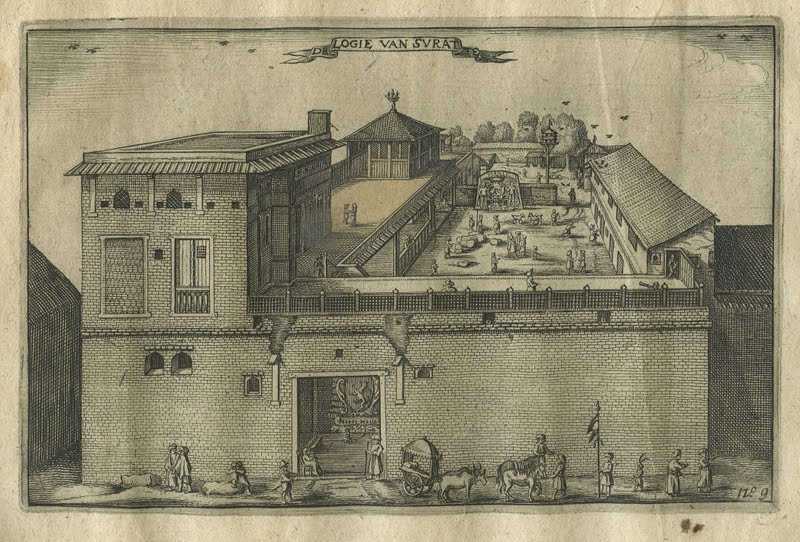
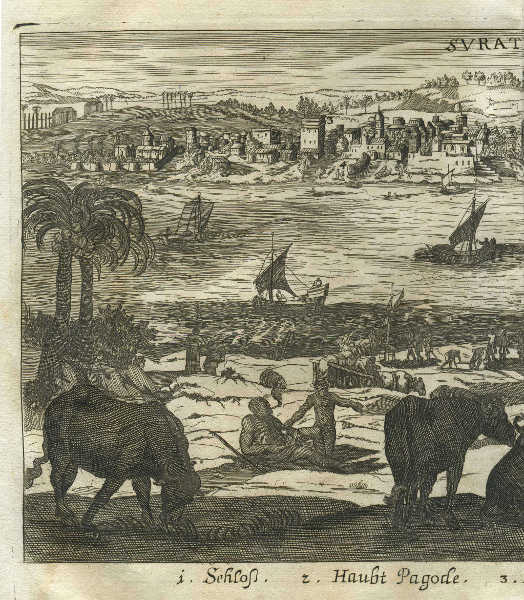
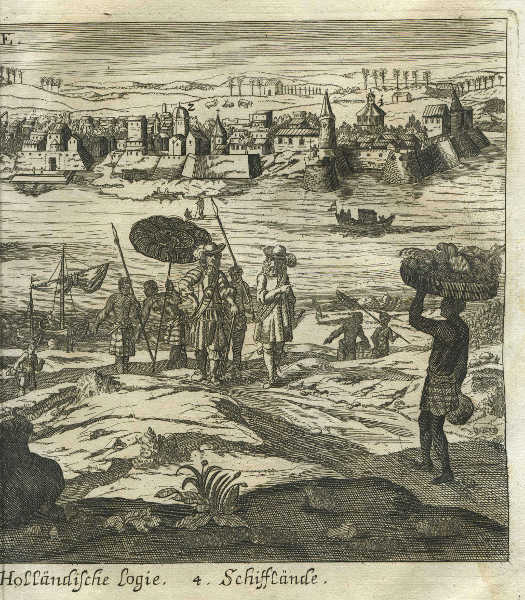

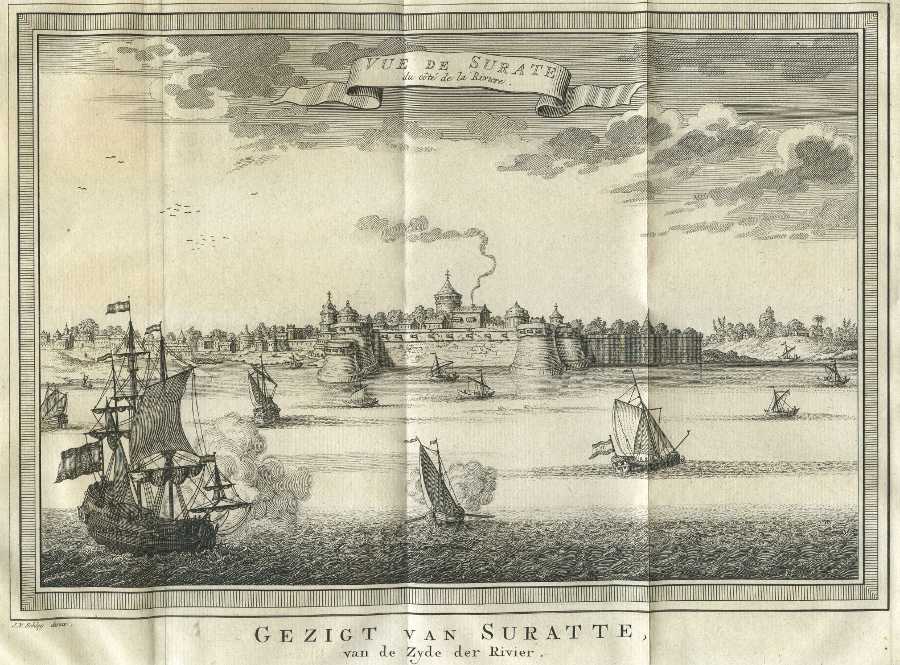

No comments:
Post a Comment